To spread the original, universal and eternal truth, path or law of yoga, which remains forever the same in essence, yet always adapts to the time and place. |
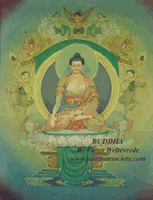 In
Hinduism, Buddha is regarded as the ninth incarnation of Vishnu, following Ram
and Krishna. That is obviously a real honour, even though
Buddhism may not see it that way. Buddhism in fact does not believe in Gods and
sees him only as the incarnation of a realized being. Nevertheless, various forms
of Buddha are worshipped in Buddhism in ways that are very similar to the worship
of Hindu gods.
In
Hinduism, Buddha is regarded as the ninth incarnation of Vishnu, following Ram
and Krishna. That is obviously a real honour, even though
Buddhism may not see it that way. Buddhism in fact does not believe in Gods and
sees him only as the incarnation of a realized being. Nevertheless, various forms
of Buddha are worshipped in Buddhism in ways that are very similar to the worship
of Hindu gods.
One example is the Amithaba Buddha, seen as the main bodhisattva form of the fire element, which is symbolized by the deity and the according deities, called the lotus family. The fire element as red color symbolizes the western region of the universe and has the lotus or nectar vase as it's symbol. The lotus stands for pure intentions of all activities and the nectar vase, filled with subtle life energy, symbolizes the immense power of this element. The Amithaba Buddha embodies wisdom and essential equality. The Amithaba Buddha is a form of Buddha that represents infinite light. He is the embodiment of the enlightened speech of all Buddha's. The Amithaba Buddha is the principal representative of the blissful pure land of the West.
Another example is the Shakyammuni Buddha, the fourth of 1000 founding buddha's predicted to appear during the coming eon. The purpose of the Shakyamunni Buddha is to reveal the path leading to full enlightenement.
The life of Budhha is an intriguing story that powerfully demonstrates the teachings of Buddhism :
In the 5. century BC., an Aryan tribe called the Shakyas was living at Kapilavastu, a state between Benares and the Himalayas. Those people depended mainly on rice and simple food and lived a farmer's life. Suddhodana, raja of the Shakyas was married to two daughters of the raja of the neighbor tribe, the Koliyans.
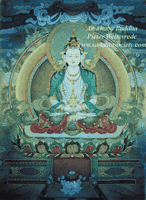 Buddha's
conception was miraculous. Mahamaya, the elder wife, had a dream in which she
was translated by devas of the four directions to the Himalayas. There she was
bathed and ceremonially purified and the Bodysattva appeared, coming from the
North in the form of a white elephant. When Buddha entered his mother's womb,
great wonders took place, trees and herbs burst into flower and untouched instruments
started to play beautiful music.
Buddha's
conception was miraculous. Mahamaya, the elder wife, had a dream in which she
was translated by devas of the four directions to the Himalayas. There she was
bathed and ceremonially purified and the Bodysattva appeared, coming from the
North in the form of a white elephant. When Buddha entered his mother's womb,
great wonders took place, trees and herbs burst into flower and untouched instruments
started to play beautiful music.
After nine months, in the year 563 BC., Mahamaya gave birth to a boy, but she died seven days later. A short time after his birth, Buddha was named prince Siddharta - Gautama was his family name. When Siddharta was twelve years old, the Brahmans told the king that his son would either become a great king or an ascetic, as the result of seeing problems, disease and death. From that time on, the king took every precaution to keep Buddha far away from the world's problems. The prince lived in a huge palace and had all kinds of comfort and beauty around.
Gautama Buddha was early married to his cousin Yashoda, daughter of the raja of Koli. At the age of 29, the problem of suffering, disease and death was impressively set before Buddha. Filled with the thought of the insecurity of all happiness and grief at the sufferings of others, Buddha felt a deep unrest and dissatisfaction with life. After ten years, his son Rahula was born, but Buddha only felt it as one more tie on the way to seek a solution for the problems of the world.
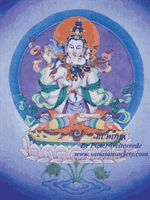 During
the same night, Buddha left his family and home to search for various Brahman
hermits and saints. Dissatisfied with their teachings, Buddha practiced alone
in the forest. After enduring the most severe penances for a long period of time,
with the greatest determination, Buddha found himself no nearer to enlightenment.
Buddha abandoned the life of an ascetic, took regular food, sacrificing his reputation
so his disciples deserted him.
During
the same night, Buddha left his family and home to search for various Brahman
hermits and saints. Dissatisfied with their teachings, Buddha practiced alone
in the forest. After enduring the most severe penances for a long period of time,
with the greatest determination, Buddha found himself no nearer to enlightenment.
Buddha abandoned the life of an ascetic, took regular food, sacrificing his reputation
so his disciples deserted him.
Buddha wandered along the banks of the river Nairanjara and took seat under a Bo-tree. After sitting there for some time, his mind was clearer and clearer, his doubts vanished and a great peace came over him. Day and night passed and by dawn came perfect knowledge and Gautama became enlightened and became the Buddha. With that enlightenment, there came also a sense of great isolation. How could Buddha share this wisdom with men, less wise and earnest ? Such isolation comes to all great leaders, but love and pity for humanity determined Buddha at all hazard of failure or misunderstanding, to preach the truth that he had seen.
Buddha proceeded to Benares to "turn the wheel of the law". Buddha preached the doctrine of nonviolence to all who could hear him. Some became his personal followers, other disciples lived a householder life. Buddha reached many people also from the higher society classes and converted the worshippers of fire by many miracles.
When Buddha visited Kapilavastu, all the nobles, hearing his doctrine, became his disciples. Buddha perceived that the time had come to visit his native city. His father the king prepared a beautiful garden for his comfort and sent to inform Yashoda, that she might also come to worship Siddharta. When Yashoda heard that Buddha was coming, she cut her hair and went to see him. She humbly bowed at his feet, not as a sudden expression of love, but out of deep devotion, because after her husband left her, she had lived like a nun. Buddha related that in a former life, it had been Yashoda's wish to be the wife of a Buddha and therefore had been his companion and helper for many years.
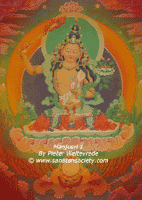 Buddha´s
parents followed his path and also Rahula, his son, was admitted to the order
of monks. Buddha refused to admit Yashoda to the order of priesthood, but many
years later, he instituted the order of Buddhist nuns and Yashoda was admitted.
She attained Nirvana two years before Buddha's own death.
Buddha´s
parents followed his path and also Rahula, his son, was admitted to the order
of monks. Buddha refused to admit Yashoda to the order of priesthood, but many
years later, he instituted the order of Buddhist nuns and Yashoda was admitted.
She attained Nirvana two years before Buddha's own death.
In the year 483 BC., at the age of 54 years, Gautama Buddha left his body in the city of Pawa, surrounded by his disciples. Buddha's last words were "work out your salvation with diligence".
Buddhism grew very popular in India and therefore Adi Shankarachaya installed the four Shankarachayas, each for one direction, to save the Hindu Religion from the influence of Buddhism.
Free Buddha & Tara Desktop Wallpaper
|
This introduction on Buddha was extracted from the book "Myths and legends of the Hindu and Buddhists", by Sister Nivedita, Ananda K. Coomaraswamy from Vivekananda Ashram, Kalkutta. See www.advaitaonline.com |
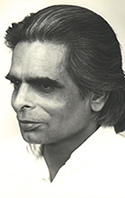 Sanatan Society is an international networking association of students of the late Harish Johari, joining efforts to promote his teachings of yoga philosophy, tantra, worship, art and love. Sanatan Society stands
for the original, universal and eternal truth, path or law of yoga.
Though it is Hindu in origin, Sanatan Society is not limited to any religion,
race, time or country, nor in fact to any particular organisation. More about Sanatan Society...
Sanatan Society is an international networking association of students of the late Harish Johari, joining efforts to promote his teachings of yoga philosophy, tantra, worship, art and love. Sanatan Society stands
for the original, universal and eternal truth, path or law of yoga.
Though it is Hindu in origin, Sanatan Society is not limited to any religion,
race, time or country, nor in fact to any particular organisation. More about Sanatan Society...